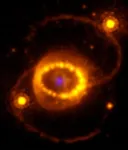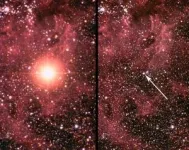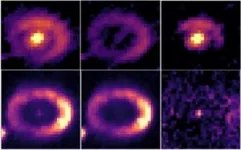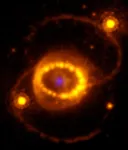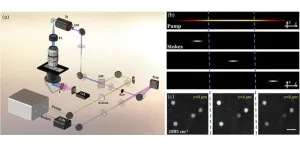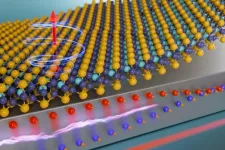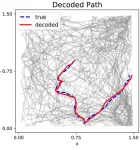(Press-News.org) A new study, published in Science and co-authored by Dr Patrick Kavanagh of Maynooth University’s Department of Experimental Physics in Ireland, has provided the first conclusive evidence for the presence of the elusive neutron star produced in the supernova SN 1987A.
Supernovae are the spectacular end result of the collapse of stars more massive than eight to ten times the mass of the sun. Besides being the main sources of chemical elements such as the carbon, oxygen, silicon, and iron that make life possible, they are also responsible for creating the most exotic objects in the universe, neutron stars and black holes.
Supernova 1987A (or SN 1987A for short) was the first naked eye supernova in four centuries and provided astronomers with an unprecedented close-up view of a supernova explosion with modern observatories. Despite being one of the most studied objects in the sky, SN 1987A is not without its mysteries, with the most enduring question being ‘what did the explosion leave behind?’
The detection of neutrinos, unimaginably small sub-atomic particles produced in the supernova, indicated that a neutron star must have formed. However, whether or not the neutron star persisted or collapsed into a black hole has been one of the biggest unknowns regarding SN 1987A.
Even after three and a half decades of intense monitoring with cutting-edge, world-class observatories, no conclusive evidence for the presence of a neutron star at the centre of SN 1987A has been found, until now.
In a study published on February 22 in the journal Science, an international team of astronomers announced their discovery with the James Webb Space Telescope (JWST) of narrow emission lines from ionized argon and sulphur atoms located at the centre of a nebula around SN 1987A.
“It was so exciting looking at the JWST observations of SN 1987A for the first time,” said Dr Kavanagh, an SFI-IRC Pathway Fellow at Maynooth University in Ireland. “As we checked the MIRI and NIRSpec data, the very bright emission from argon at the centre of SN 1987A jumped out. We knew immediately that this was something special that could finally answer the question on the nature of the compact object.”
The authors of the study show that the emission line strengths observed by JWST must be triggered by radiation from the hot neutron star or from a pulsar wind nebula around the neutron star.
“Thanks to the superb spatial resolution and excellent instruments on JWST we have for the first time been able to probe the center of the supernova and what was created there,” said Claes Fransson of Stockholm University, the lead author of the study.
“We now know that there is a compact source of ionizing radiation, most likely by a neutron star. We have been looking for this from the time of the explosion, but had to wait for JWST to be able to verify the predictions.”
About Supernova (SN) 1987A
SN 1987A is the most studied and best observed supernova of all and therefore of special importance for understanding these objects. Exploding on 23 February 1987 in the Large Magellanic Cloud in the southern sky at a distance of 160,000 light years, it was the closest supernova since the last naked eye supernova observed by Johannes Kepler in 1604.
For several months before it faded SN 1987A could be seen with the naked eye even at this distance. Even more importantly, it is the only supernova to have been detected via its neutrinos. This is highly significant since 99.9 % of the enormous energy emitted in this event was predicted to be lost as these extremely weakly interacting particles.
The remaining 0.1 % appears in the expansion energy of the remnant and as light. Of the huge number -- about 1058 -- of neutrinos emitted, about 20 were detected by three different detectors around the Earth, from the collapse in the core of the star on February 23 at 7:35:35 UT.
SN 1987A was also the first supernova where the star which exploded could be identified from images that had been taken before the explosion.
Besides the neutrinos, the most interesting result of the collapse and explosion is the prediction that a black hole or neutron star was created. This constitutes only the central core of the collapsed star, with a mass of 1.5 times that of the Sun. The rest is expelled with a velocity up to 10% of the speed of light, forming the expanding remnant we observe directly today.
The ‘long’ 10-second duration of the neutrino burst indicated the formation of a neutron star, but despite several interesting indications from radio and X-ray observations, no conclusive evidence for a compact object had been found until now, and was the main remaining unsolved problem for SN 1987A.
An important reason for this may be the large mass of dust particles that we know was formed during the years after explosion. This dust could block most of the visible light from the center and therefore hide the compact object at visible wavelengths. This has now changed with the observation of SN 1987A at infrared wavelengths by a team using the James Webb Space Telescope.
END
Maynooth University partners in study published in Science that finds evidence of elusive neutron star
A new study, published in Science and co-authored by Dr Patrick Kavanagh of Maynooth University’s Experimental Physics Department, has provided the first conclusive evidence for the presence of the elusive neutron star produced in the supernova SN 1987A
2024-02-22
ELSE PRESS RELEASES FROM THIS DATE:
James Webb telescope detects traces of neutron star in iconic supernova
2024-02-22
Scientists can finally show that a neutron star formed from our most well-studied supernova, SN 1987A. The breakthrough was made possible thanks to the James Webb telescope.
Supernovae are the spectacular end result of the collapse of stars more massive than 8-10 times the mass of the sun. Besides being the main sources of chemical elements such as carbon, oxygen, silicon, and iron that make life possible, they are also responsible for creating the most exotic objects in the universe, neutron stars and black holes.
In 1987, supernova 1987A (SN 1987A) ...
Enhanced 3D chemical imaging with phase-modulation
2024-02-22
Understanding complex biological and biomedical systems is greatly aided by 3D imaging, which provides much more detailed information than traditional two-dimensional methods. However, live cell and tissue imaging remain challenging due to factors like limited imaging speed and significant scattering in turbid environments.
In this context, multimodal microscopy techniques are notable. Specifically, nonlinear techniques like CRS (coherent Raman scattering) use optical vibrational spectroscopy, providing precise chemical imaging in tissues and cells in a label-free way. Furthermore, stimulated Raman scattering (SRS) ...
Researchers harness 2D magnetic materials for energy-efficient computing
2024-02-22
CAMBRIDGE, MA — Experimental computer memories and processors built from magnetic materials use far less energy than traditional silicon-based devices. Two-dimensional magnetic materials, composed of layers that are only a few atoms thick, have incredible properties that could allow magnetic-based devices to achieve unprecedented speed, efficiency, and scalability.
While many hurdles must be overcome until these so-called van der Waals magnetic materials can be integrated into functioning computers, MIT researchers took an important step in this direction by demonstrating precise control of a van der ...
Empowering autistic teens: New clinician advice for navigating chronic pain
2024-02-22
When you’re an autistic teenager living with chronic pain, getting treatment for your pain can be a challenging experience. That’s according to a group of young people who’ve spoken to Dr. Abbie Jordan of the Department of Psychology and Centre for Pain Research at The University of Bath about their experiences. Teenagers mention sensory issues, a lack of autism awareness among staff, or feeling “doubly different” compared to their peers, making receiving “one-size-fits-all” psychologically focused treatment for their chronic pain ...
Climate change linked to rise in mental distress among teens, according to Drexel study
2024-02-22
Worsening human-induced climate change may have effects beyond the widely reported rising sea levels, higher temperatures, and impacts on food supply and migration – and may also extend to influencing mental distress among high schoolers in the United States.
According to a representative survey of 38,616 high school students from 22 public school districts in 14 U.S. states, the quarter of those adolescents who had experienced the highest number of days in a climate disaster within the past two years and the past five years – such as hurricanes, floods, tornadoes, droughts, and wildfire – had 20% higher odds of developing mental ...
Combination of group competition and repeated interactions promotes cooperation
2024-02-22
One of the great unresolved mysteries of human evolution is how pro-social, cooperative behavior could have evolved. What led to the establishment of a behavior that prioritizes the benefit of the community over that of the individual in a world where materially successful individuals reproduce, and others slowly perish?
The prevailing theory suggests that this occurred due to repeated interactions. Over generations, humans learned that cooperative behavior pays off in the long run. People collaborate because they anticipate interacting with the same individuals ...
A new beginning: The search for more temperate Tatooines
2024-02-22
New Haven, Conn. — Luke Skywalker’s childhood might have been slightly less harsh if he’d grown up on a more temperate Tatooine — like the ones identified in a new, Yale-led study.
According to the study’s authors, there are more climate-friendly planets in binary star systems — in other words, those with two suns — than previously known. And, they say, it may be a sign that, at least in some ways, the universe leans in the direction of orderly alignment rather than chaotic misalignment.
For the study, ...
Moffitt study highlights urgent need to address impact of extreme weather events on cancer survivorship
2024-02-22
TAMPA, Fla. — Hurricanes and other extreme weather events pose immediate threats to life and property and have long-lasting impacts on health outcomes, particularly for cancer survivors. In a mini-review published today in Cancer Epidemiology, Biomarkers & Prevention, a journal from the American Association for Cancer Research, Moffitt Cancer Center researchers shed light on the significant gaps in understanding and addressing the effects of hurricanes and extreme weather events on biological, psychosocial and clinical outcomes among cancer survivors.
Researchers ...
Scientists can tell where a mouse is looking and located based on its neural activity
2024-02-22
Researchers have paired a deep learning model with experimental data to “decode” mouse neural activity. Using the method, they can accurately determine where a mouse is located within an open environment and which direction it is facing just by looking at its neural firing patterns. Being able to decode neural activity could provide insight into the function and behavior of individual neurons or even entire brain regions. These findings, publishing February 22 in Biophysical Journal, could also inform the design of intelligent machines that currently ...
Artificial intelligence matches or outperforms human specialists in retina and glaucoma management, Mount Sinai study finds
2024-02-22
A large language model (LLM) artificial intelligence (AI) system can match, or in some cases outperform, human ophthalmologists in the diagnosis and treatment of patients with glaucoma and retina disease, according to research from New York Eye and Ear Infirmary of Mount Sinai (NYEE).
The provocative study, published February 22, in JAMA Ophthalmology, suggests that advanced AI tools, which are trained on vast amounts of data, text, and images, could play an important role in providing decision-making support to ophthalmologists in the diagnosis and management of cases involving glaucoma and retina ...
LAST 30 PRESS RELEASES:
Young adults commonly mix cannabis with nicotine and tobacco
Comprehensive review illuminates tau protein's dual nature in brain health, disease, and emerging psychiatric connections
Book prepares K-12 leaders for the next public health crisis
Storms in the Southern Ocean mitigates global warming
Seals on the move: Research reveals key data for offshore development and international ecology
Sports injuries sustained during your period might be more severe
World's first successful 2 Tbit/s free-space optical communication using small optical terminals mountable on satellites and HAPS
Can intimate relationships affect your heart? New study says ‘yes’
Scalable and healable gradient textiles for multi‑scenario radiative cooling via bicomponent blow spinning
Research shows informed traders never let a good climate crisis go to waste
Intelligent XGBoost framework enhances asphalt pavement skid resistance assessment
Dual-function biomaterials for postoperative osteosarcoma: Tumor suppression and bone regeneration
New framework reveals where transport emissions concentrate in Singapore
NTP-enhanced lattice oxygen activation in Ce-Co catalysts for low-temperature soot combustion
Synergistic interface engineering in Cu-Zn-Ce catalysts for efficient CO2 hydrogenation to methanol
COVID-19 leaves a lasting mark on the human brain
Scientists use ultrasound to soften and treat cancer tumors without damaging healthy tissue
Community swimming program for Black youth boosts skills, sense of belonging, study finds
Specific depressive symptoms in midlife linked to increased dementia risk
An ‘illuminating’ design sheds light on cholesterol
Who is more likely to get long COVID?
Study showcases resilience and rapid growth of “living rocks”
Naval Research Lab diver earns Office of Naval Research 2025 Sailor of the Year
New Mayo-led study establishes practical definition for rapidly progressive dementia
Fossil fuel industry’s “climate false solutions” reinforce its power and aggravate environmental injustice
Researchers reveal bias in a widely used measure of algorithm performance
Alcohol causes cancer. A study from IOCB Prague confirms damage to DNA and shows how cells defend against it
Hidden viruses in wastewater treatment may shape public health risks, study finds
Unlock the power of nature: how biomass can transform climate mitigation
Biochar reshapes hidden soil microbes that capture carbon dioxide in farmland
[Press-News.org] Maynooth University partners in study published in Science that finds evidence of elusive neutron starA new study, published in Science and co-authored by Dr Patrick Kavanagh of Maynooth University’s Experimental Physics Department, has provided the first conclusive evidence for the presence of the elusive neutron star produced in the supernova SN 1987A
